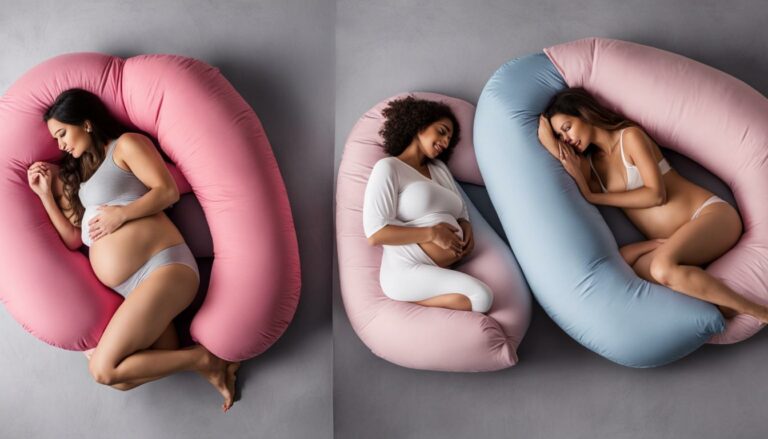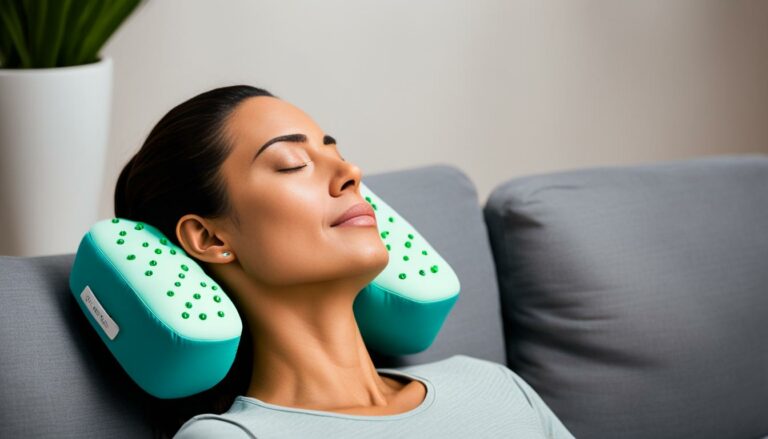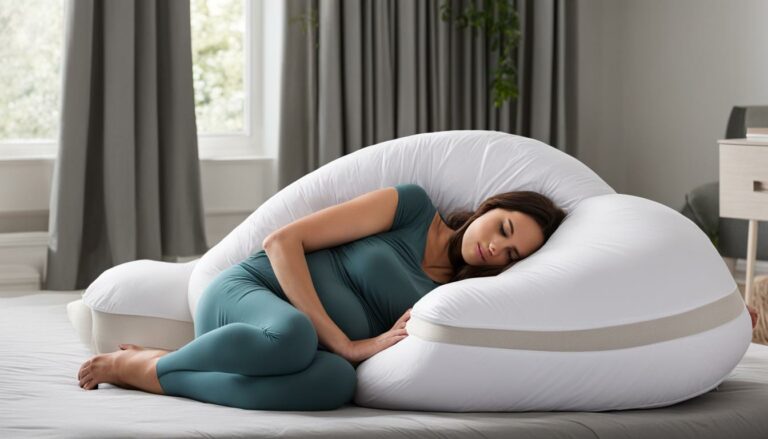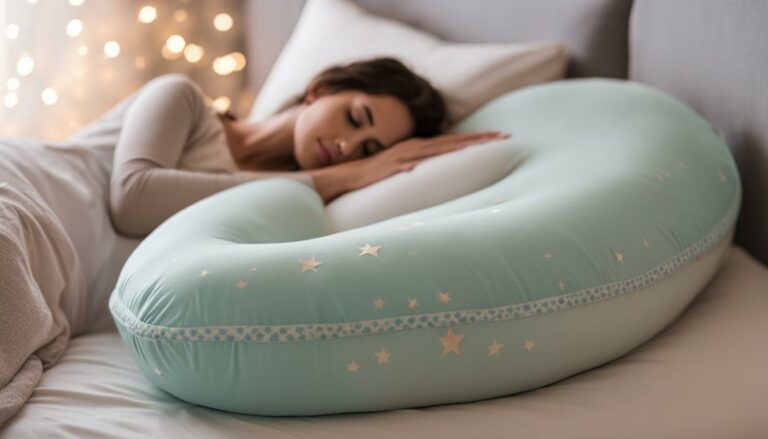Ease Back Pain: Use a Pregnancy Pillow Correctly
Eric Christie stands as a luminary in the bedding industry, with a career spanning nearly four decades since the early 1980s. His journey through the world of bedding has seen him wear many hats – a manufacturer, designer, and retailer, showcasing his versatility and expertise in Read more...
pillowsandbedsheets.com and its partners may earn a commission if you purchase a product through one of our links
Are you struggling with back pain during your pregnancy? You’re not alone. Many expectant mothers experience discomfort, especially in the lower back and hips. But there’s a solution that can offer you much-needed relief – a pregnancy pillow. Using a pregnancy pillow correctly can help alleviate back pain and promote a more comfortable sleep.
Key Takeaways:
- Using a pregnancy pillow correctly can help alleviate back pain during pregnancy.
- Pregnancy pillows come in different types, such as C-shaped pillows, U-shaped pillows, and pillow wedges.
- It’s important to find the right sleeping positions with a pregnancy pillow to maximize its benefits.
- A pregnancy pillow can provide support and promote neutral spinal alignment, reducing strain and discomfort.
- Choose a pregnancy pillow that suits your specific needs and preferences for optimal comfort.
What is a Pregnancy Pillow and What are the Types?
Pregnancy pillows are body support pillows specifically designed to improve comfort and sleep during pregnancy. They provide additional support to the body, helping to alleviate common pregnancy-related discomforts, such as back pain and hip pain. There are different types of pregnancy pillows available, each offering unique features and benefits.
C-Shaped Pregnancy Pillows
The first type of pregnancy pillow is the C-shaped pillow. This pillow is curved in the shape of a letter “C” and is designed to be placed behind the back and between the knees. The C-shape provides optimal back support and helps maintain proper spinal alignment while promoting a comfortable sleeping position.
U-Shaped Pregnancy Pillows
The second type is the U-shaped pregnancy pillow. As the name suggests, this pillow is shaped like the letter “U” and provides full-body support. It surrounds the head and both sides of the body, offering support to the neck, back, hips, and knees. The U-shaped pillow is perfect for those who prefer to sleep in a more cocooned position.
Pillow Wedges
The third type of pregnancy pillow is the pillow wedge. This is a smaller-sized pillow that can be placed behind the back or underneath the belly for additional support. It is versatile and can be used in various positions to target specific areas of discomfort. The pillow wedge is great for providing targeted support and relief to specific problem areas.
Each type of pregnancy pillow has its own unique benefits, and the choice ultimately depends on your personal preferences and needs. Some pregnant women may find a specific type more comfortable than others, so it’s important to consider factors such as body size, sleeping position, and the areas where you experience the most discomfort.
Now that you know the different types of pregnancy pillows available, it’s time to explore the best sleeping positions and how to incorporate a pregnancy pillow for optimal relief and comfort.
When should you start sleeping with a Pregnancy Pillow?
It is not necessary to sleep with a pregnancy pillow, but many pregnant women find it helpful for finding a comfortable sleeping position. Most women experience increased difficulty finding a comfortable sleeping position or struggle with rolling over around 20 weeks of pregnancy. This can be a good time to try using a supportive maternity pillow to create a comfortable sleep space.

Best Sleeping Positions with Pregnancy Pillows
When it comes to finding comfort and relief from back pain during pregnancy, utilizing the right sleeping positions with pregnancy pillows can make a significant difference. Pregnancy pillows offer support and alignment to help alleviate discomfort and promote better sleep quality. Here are some of the best sleeping positions to try with different types of pregnancy pillows:
C-shaped Pregnancy Pillow
If you’re using a C-shaped pregnancy pillow, a great position is to place it behind your back, allowing the curved end to wrap around your body. Rest your head on the curved section and position the end of the pillow between your knees. This setup provides optimal back support, relieving pressure and promoting better alignment.
U-shaped Pregnancy Pillow
For full-body support, the U-shaped pregnancy pillow is a fantastic option. Place the pillow behind your head, allowing it to envelop both sides of your body. This position provides comprehensive support from head to toe and is particularly beneficial for back pain relief.
I-shaped Pregnancy Pillow (Body Pillow)
If you prefer a more versatile pillow, the I-shaped pregnancy pillow, also known as a body pillow, offers excellent support. You can place it on the side that you want to be supported, whether it’s behind your back or under your belly. This pillow is highly customizable to meet your specific comfort needs.
It’s essential to find the sleeping position that works best for you and your unique needs. Experiment with different combinations and pillow placements to discover the setup that provides the most relief and comfort.
| Pregnancy Pillow Type | Recommended Sleeping Position |
|---|---|
| C-shaped Pregnancy Pillow | Behind the back with head and knee support |
| U-shaped Pregnancy Pillow | Behind the head for full-body support |
| I-shaped Pregnancy Pillow (Body Pillow) | Customizable support based on personal preference |
Remember, each pregnancy pillow offers unique benefits, so choose the one that provides the most comfort and targeted relief for your back pain. By incorporating these sleeping positions with pregnancy pillows into your routine, you can improve your sleep quality and wake up feeling refreshed and pain-free.
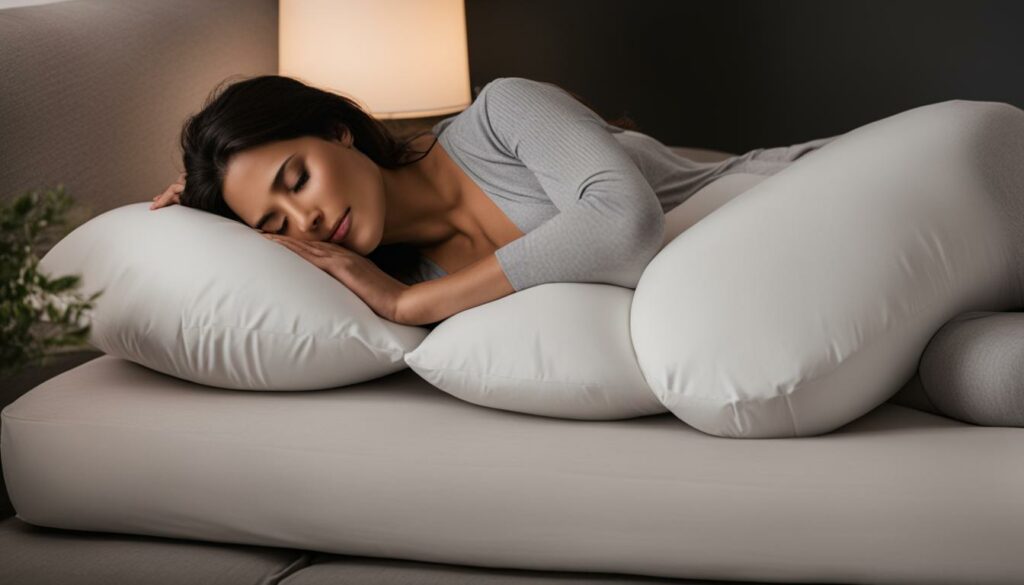
Benefits of Using a Pregnancy Pillow for Back Pain
Using a pregnancy pillow for back pain during pregnancy offers multiple benefits. Here’s how it can help:
- Promotes Neutral Spinal Alignment: A pregnancy pillow helps align your spine properly, relieving pressure on your back and hips. By maintaining a neutral spinal alignment, it reduces strain and discomfort, allowing for a more comfortable sleep.
- Supports Muscles and Joints: The pregnancy pillow provides support to the muscles and joints from the hips to the knees. This support reduces the strain on these areas and helps alleviate back pain.
- Improves Comfort and Sleep Quality: Using a pregnancy pillow improves overall comfort and sleep quality during pregnancy. It assists in finding a comfortable sleeping position, reducing tossing and turning, and promoting a more restful sleep.
| Benefits | How It Works |
|---|---|
| Promotes Neutral Spinal Alignment | Relieves pressure on the back and hips by aligning the spine correctly. |
| Supports Muscles and Joints | Reduces strain and discomfort by providing support to the hips and knees. |
| Improves Comfort and Sleep Quality | Enhances overall comfort, reduces tossing and turning, and promotes better sleep. |
Using a pregnancy pillow for back pain relief brings numerous benefits, including promoting neutral spinal alignment, supporting muscles and joints, and improving comfort and sleep quality during pregnancy.

Tips for Using a Pregnancy Pillow for Back Pain
When experiencing back pain during pregnancy, using a pregnancy pillow correctly can make a significant difference in your comfort and relief. Here are some tips to help you maximize the benefits of your pregnancy pillow:
- Experiment with positions: Try different positions and pillow placements to find what works best for you. Every woman’s body is unique, so it’s essential to find the position that provides the most comfort and support for your back pain.
- Focus on support: Position the pregnancy pillow to target the areas where you experience the most pain. Whether it’s your lower back, hips, or shoulders, make sure the pillow is providing adequate support to alleviate discomfort and strain.
- Combine pillows if needed: If you require additional support, consider using the pregnancy pillow in conjunction with other pillows. For example, placing a smaller pillow or cushion between your knees can help improve alignment and reduce pressure on your back.
Remember, the key to using a pregnancy pillow effectively is finding the right position and pillow placement that offers maximum comfort and support for your back pain. Don’t be afraid to experiment and adjust until you discover what works best for you.
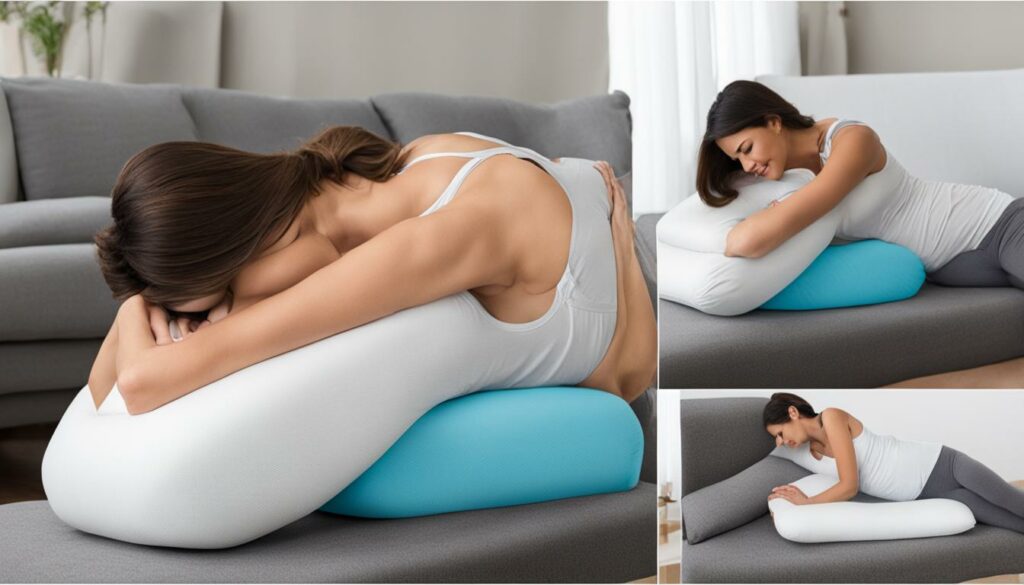
Choosing the Right Pregnancy Pillow for Back Pain
When it comes to finding relief for your back pain during pregnancy, choosing the right pregnancy pillow is key. Considering your specific needs and preferences will guide you in selecting a pillow that offers the support you require. Take into account factors such as the pillow’s shape, material, and firmness to ensure maximum comfort.
There are various types of pregnancy pillows available, each designed to target different areas of the body and provide specific support. Let’s explore some popular options:
C-shaped pregnancy pillows:
C-shaped pregnancy pillows are versatile and can be used in multiple positions. They wrap around your back and can be placed between your knees for optimal spinal alignment and support.
U-shaped pregnancy pillows:
U-shaped pregnancy pillows offer full-body support and are ideal for those who prefer to sleep on their sides. They cradle the head and surround the body, providing support from head to toe.
Pillow wedges:
Pillow wedges are smaller and more portable. They can be placed behind your back or under your belly to provide targeted support where you need it most.
Remember to choose a pregnancy pillow that complements your individual requirements. Here’s a helpful table summarizing the main features of each type:
| Pillow Type | Shape | Material | Firmness |
|---|---|---|---|
| C-shaped | Curved shape to wrap around body | Soft and breathable | Medium firmness |
| U-shaped | Curved shape to surround body | Plush and supportive | Medium to firm |
| Pillow wedges | Rectangular shape | Contoured and durable | Variable, depending on the brand |
Consider these factors as you make your decision, and remember that finding a pregnancy pillow that aligns with your comfort preferences is key to obtaining the relief you need. Here is an image of different pregnancy pillows to help you visualize their shapes:
By choosing a pregnancy pillow that meets your needs and preferences, you’ll be on your way to enjoying a more comfortable and pain-free sleep during pregnancy. Experiment with different positions and pillow placements to find the one that works best for you.
Incorporating a Pregnancy Pillow for Back Pain Relief
To find relief from back pain during pregnancy, it’s essential to incorporate a pregnancy pillow into your routine. Consistently using the pillow in the recommended positions can provide optimal support and alleviate discomfort. Make it a habit to include the pregnancy pillow in your regular sleep routine, adjusting it as needed to ensure maximum comfort. Additionally, you can utilize the pregnancy pillow for other activities, such as reading or watching TV in a seated position, to continue benefiting from its back pain relief properties.
Using a pregnancy pillow regularly can provide significant relief from back pain throughout your pregnancy journey. It supports proper spinal alignment, reduces pressure on the back and hips, and promotes overall comfort and relaxation. By incorporating this simple yet effective tool into your daily routine and various activities, you can enjoy a more comfortable and pain-free pregnancy experience.
Pregnancy Pillow Exercises for Back Pain Relief
While pregnancy pillows are primarily used for sleep and relaxation, they can also be incorporated into exercises for back pain relief. These exercises can help target specific areas of discomfort and strengthen the muscles that support your back. It’s important to consult with a healthcare professional or a prenatal fitness instructor before starting any exercise program during pregnancy.
Exercise 1: Pelvic Tilts with Pregnancy Pillow
The pelvic tilt exercise can help relieve lower back pain and strengthen your abdominal muscles.
- Lie on your back with your legs bent and your feet flat on the floor.
- Place the pregnancy pillow underneath your lower back for support.
- Inhale, and as you exhale, tilt your pelvis forward, pressing your lower back into the pillow.
- Hold for a few seconds, then release.
- Repeat 10-15 times, gradually increasing as your comfort allows.
Exercise 2: Cat-Cow Stretch with Pregnancy Pillow
The cat-cow stretch targets the muscles in your back and helps improve flexibility and relieve tension.
- Get down on all fours, with your hands directly under your shoulders and your knees hip-width apart.
- Place the pregnancy pillow underneath your knees for support.
- As you inhale, lift your chest and tailbone towards the ceiling, arching your back (cow pose).
- As you exhale, round your spine, tucking your chin and tailbone under (cat pose).
- Repeat this fluid movement for 8-10 repetitions, focusing on the breath.
Exercise 3: Squats with Pregnancy Pillow
Squats can help strengthen the muscles in your legs, buttocks, and lower back.
- Stand with your feet shoulder-width apart, toes slightly turned out.
- Hold the pregnancy pillow against your chest with both hands.
- Lower your body by bending your knees and hips, keeping your back straight.
- Go as low as comfortable while maintaining proper form.
- Push through your heels to return to the starting position.
- Repeat for 10-15 repetitions, gradually increasing as your strength improves.
Exercise 4: Side-Lying Leg Lifts with Pregnancy Pillow
Side-lying leg lifts can help strengthen your hips and glutes, providing support for your lower back.
- Lie on your side with the pregnancy pillow between your legs for support.
- Align your body and keep your bottom leg straight.
- Engage your core muscles and lift your top leg as high as comfortable without straining.
- Lower the leg back down.
- Repeat for 10-15 repetitions on each side, gradually increasing as your endurance improves.
Remember to listen to your body and stay within your comfort limits during these exercises. If you experience any pain or discomfort, stop immediately and consult with a healthcare professional.
Using a pregnancy pillow for back pain relief can provide additional support and enhance the effectiveness of these exercises. The unique shape and design of pregnancy pillows can help maintain proper alignment and alleviate strain on your back while performing these exercises.
Benefits of Using a Pregnancy Pillow Beyond Pregnancy
A pregnancy pillow can continue to provide numerous benefits even after pregnancy. Here are some ways you can make the most out of your pregnancy pillow:
- Support during Postpartum Recovery: After delivery, your body needs time to recover, and a pregnancy pillow can offer much-needed support. Whether you had a vaginal birth or a cesarean section, the pillow can help alleviate discomfort and provide relief for your muscles as they heal.
- Comfortable Breastfeeding or Bottle-Feeding: Breastfeeding or bottle-feeding your baby requires sitting or reclining in a comfortable position. A pregnancy pillow can provide the necessary support to your back, neck, and arms, ensuring a comfortable and enjoyable feeding experience for both you and your little one.
- Assisting Your Baby’s Development: As your baby grows and becomes more active, the pregnancy pillow can serve as a useful aid. It can be used to prop up your baby when they are learning to sit independently, providing additional support and stability.
“A pregnancy pillow is a versatile tool that can continue to serve you well beyond pregnancy. It can offer support during your postpartum recovery, enhance your breastfeeding or bottle-feeding experience, and aid in your baby’s development.”
As you can see, a pregnancy pillow has uses far beyond pregnancy, making it a valuable investment for new moms. Its versatility and ability to provide support and comfort make it an essential accessory throughout your motherhood journey.
Continue reading to discover tips for caring for your pregnancy pillow and how to choose the right one for your specific needs.
Caring for Your Pregnancy Pillow
To maintain the hygiene and longevity of your pregnancy pillow, it’s important to follow the care instructions provided by the manufacturer. Proper care not only keeps your pregnancy pillow clean, but also ensures that it continues to provide optimal support and comfort throughout your pregnancy.
Removable and Washable Covers
Most pregnancy pillows come with removable and washable covers, making it easy to keep them clean. To clean the cover, simply follow the manufacturer’s instructions. In general, it is recommended to wash the cover in cold water with a gentle detergent. Avoid using bleach or harsh chemicals that can damage the fabric.
Proper care not only keeps your pregnancy pillow clean, but also ensures that it continues to provide optimal support and comfort throughout your pregnancy.
After washing the cover, allow it to air dry or tumble dry on a low setting. Make sure the cover is completely dry before putting it back on the pillow to prevent mold or mildew growth.
In addition to regular washing, it’s a good idea to use a pillowcase or a pillow protector underneath the cover for added protection. This will help protect the pillow from stains and spills, prolonging its lifespan.
Clean and Dry Environment
Aside from washing the cover, it’s also important to keep the pregnancy pillow in a clean and dry environment. Avoid placing it on damp surfaces or in areas with high humidity, as this can promote the growth of bacteria or mold.
If you accidentally spill something on the pillow, clean it as soon as possible to prevent stains from setting in. Use a mild detergent and a damp cloth to gently dab the affected area. Avoid rubbing or scrubbing, as this can damage the fabric.
Proper Storage
When not in use, store your pregnancy pillow in a cool, dry place, away from direct sunlight. This helps prevent discoloration and keeps the pillow in good condition.
If your pregnancy pillow is inflatable or can be packed away, make sure to deflate or fold it according to the manufacturer’s instructions. This not only saves space but also prevents unnecessary wear and tear.
By caring for your pregnancy pillow properly, you can ensure that it maintains its cleanliness and durability throughout your pregnancy and beyond.
Conclusion
In conclusion, incorporating a pregnancy pillow into your routine can be a game-changer when it comes to relieving back pain during pregnancy. By using it correctly, you can find much-needed relief and improve your overall comfort and sleep quality.
When selecting a pregnancy pillow, it’s essential to consider your specific needs and preferences. There are various types available, such as C-shaped pillows, U-shaped pillows, and pillow wedges. Choose the one that suits you best and provides optimal support where you need it the most.
It’s worth noting that a pregnancy pillow isn’t limited to just sleep. You can also use it for other activities, such as reading or watching TV in a seated position. Additionally, consult a healthcare professional or a prenatal fitness instructor for exercises that can be done with a pregnancy pillow to target back pain.
Lastly, remember to take care of your pregnancy pillow to ensure its cleanliness and durability. Follow the care instructions provided by the manufacturer, including regularly washing the removable cover and keeping the pillow in a clean and dry environment.
FAQ
How should I use a pregnancy pillow for back pain relief?
To use a pregnancy pillow for back pain relief, place it behind your back, lay your head on the part that reaches around, and place the end between your knees. Experiment with different positions and pillow placements to find what works best for you.
What are the different types of pregnancy pillows?
The three most popular types of pregnancy pillows are C-shaped pillows, U-shaped pillows, and pillow wedges. C-shaped pillows can be placed behind the back and between the knees, U-shaped pillows provide full-body support, and pillow wedges are smaller and can be placed behind the back or underneath the belly.
When should I start using a pregnancy pillow?
Many pregnant women find it helpful to start using a pregnancy pillow around 20 weeks of pregnancy when they experience increased difficulty finding a comfortable sleeping position or struggle with rolling over.
What are the best sleeping positions with pregnancy pillows?
The best sleeping positions with pregnancy pillows depend on your needs. Some options include placing a C-shaped pillow behind your back and between your knees for optimal back support, or placing it in front of you as you lay down on your side for front support. A U-shaped pregnancy pillow can be placed behind the head to support both sides of the body, while an I-shaped pillow can be used to support the side you want.
What are the benefits of using a pregnancy pillow for back pain?
Using a pregnancy pillow for back pain can promote neutral spinal alignment, relieve pressure on the back and hips, and support the muscles and joints from the hips to the knees. It can also improve overall comfort and sleep quality during pregnancy.
Do you have any tips for using a pregnancy pillow for back pain?
Yes! Some tips for using a pregnancy pillow for back pain include finding the right position and pillow placement for maximum comfort and support, combining the pregnancy pillow with other pillows if needed, and using it consistently as part of your sleep routine. Experiment with different positions and pillow placements to find what works best for you.
How do I choose the right pregnancy pillow for back pain?
When choosing a pregnancy pillow for back pain, consider your specific needs and preferences. Look for a pillow that offers support where you need it the most and consider factors such as shape, material, and firmness. It’s important to find a pregnancy pillow that is comfortable and suits your individual requirements.
How can I incorporate a pregnancy pillow for back pain relief?
To incorporate a pregnancy pillow for back pain relief, use it consistently and in the recommended positions. Make it a part of your regular sleep routine and adjust it as needed to provide optimal support. You can also use the pregnancy pillow for other activities such as reading or watching TV in a seated position.
Are there any specific exercises I can do with a pregnancy pillow to relieve back pain?
Yes! Consult with a healthcare professional or a prenatal fitness instructor for specific exercises that can be done with a pregnancy pillow to target back pain. They can provide guidance on exercises that are safe and effective for relieving back pain during pregnancy.
Can a pregnancy pillow be used beyond pregnancy?
Yes, a pregnancy pillow can continue to be useful after delivery. It can be used to support your body while your muscles recover from the delivery process and can also be used for support while breastfeeding or bottle-feeding your baby. Additionally, as your baby gets older, the pregnancy pillow can be used to prop them up as they learn to sit on their own.
How do I care for my pregnancy pillow?
To maintain the hygiene and longevity of your pregnancy pillow, follow the care instructions provided by the manufacturer. Most pregnancy pillows come with removable and washable covers, allowing for easy cleaning. Regularly washing the cover and keeping the pillow in a clean and dry environment can help prolong its lifespan.
Eric Christie stands as a luminary in the bedding industry, with a career spanning nearly four decades since the early 1980s. His journey through the world of bedding has seen him wear many hats – a manufacturer, designer, and retailer, showcasing his versatility and expertise in Read more...


